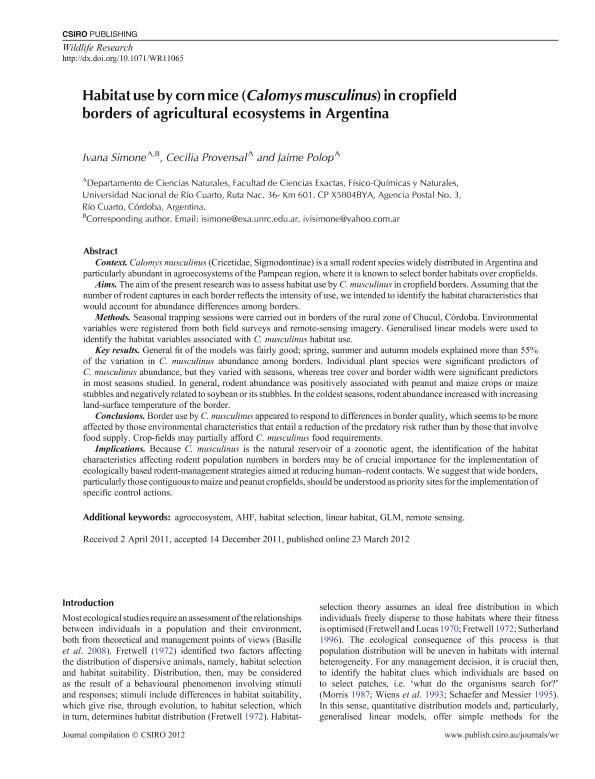Artículo
Habitat use by corn mice (Calomys musculinus) in cropfield borders of agricultural ecosystems in Argentina
Fecha de publicación:
03/2012
Editorial:
Csiro Publishing
Revista:
Wildlife Research
ISSN:
1035-3712
e-ISSN:
1448-5494
Idioma:
Inglés
Tipo de recurso:
Artículo publicado
Clasificación temática:
Resumen
Context Calomys musculinus (Cricetidae, Sigmodontinae) is a small rodent species widely distributed in Argentina and particularly abundant in agroecosystems of the Pampean region, where it is known to select border habitats over cropfields. Aims The aim of the present research was to assess habitat use by C. musculinus in cropfield borders. Assuming that the number of rodent captures in each border reflects the intensity of use, we intended to identify the habitat characteristics that would account for abundance differences among borders. Methods Seasonal trapping sessions were carried out in borders of the rural zone of Chucul, Crdoba. Environmental variables were registered from both field surveys and remote-sensing imagery. Generalised linear models were used to identify the habitat variables associated with C. musculinus habitat use. Key results General fit of the models was fairly good; spring, summer and autumn models explained more than 55% of the variation in C. musculinus abundance among borders. Individual plant species were significant predictors of C. musculinus abundance, but they varied with seasons, whereas tree cover and border width were significant predictors in most seasons studied. In general, rodent abundance was positively associated with peanut and maize crops or maize stubbles and negatively related to soybean or its stubbles. In the coldest seasons, rodent abundance increased with increasing land-surface temperature of the border. Conclusions Border use by C. musculinus appeared to respond to differences in border quality, which seems to be more affected by those environmental characteristics that entail a reduction of the predatory risk rather than by those that involve food supply. Crop-fields may partially afford C. musculinus food requirements. Implications Because C. musculinus is the natural reservoir of a zoonotic agent, the identification of the habitat characteristics affecting rodent population numbers in borders may be of crucial importance for the implementation of ecologically based rodent-management strategies aimed at reducing humanrodent contacts. We suggest that wide borders, particularly those contiguous to maize and peanut cropfields, should be understood as priority sites for the implementation of specific control actions.
Palabras clave:
AGROECOSYSTEM
,
AHF
,
GLM
,
HABITAT SELECTION
,
LINEAR HABITAT
,
REMOTE SENSING.
Archivos asociados
Licencia
Identificadores
Colecciones
Articulos(CCT - CORDOBA)
Articulos de CTRO.CIENTIFICO TECNOL.CONICET - CORDOBA
Articulos de CTRO.CIENTIFICO TECNOL.CONICET - CORDOBA
Citación
Simone, Ivana; Provensal, María Cecilia; Polop, Jaime Jose; Habitat use by corn mice (Calomys musculinus) in cropfield borders of agricultural ecosystems in Argentina; Csiro Publishing; Wildlife Research; 39; 2; 3-2012; 112-122
Compartir
Altmétricas




